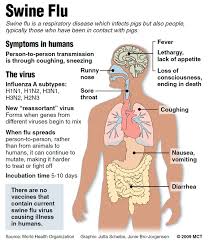Swine Flu is also known as H1N1 Flu. It was 1st identified in 1930 in United States (U.S.) that has started up from the pigs, which has been recognized by the veterinarians and the pork producers. In 2009 Swine Flu was started spreading very fast around the world. In 2009, investigators decided, Swine Flu was 1st seen in Mexico and it is termed as H1N1 that exhibits 2 main surface antigens named as hemagglutinin type 1 (H1) and neuraminidase type1 (N1). The H1N1 flu includes 8 RNA strands, among them 5 strands are derived from swine strains, 2 strands are derived from avian (bird) strains and 1 strand derived from human flu strains.
What is Swine Flu?

The world health organization (WHO) called Swine Flu as a pandemic and it is a disease of pigs caused by the “influenza viruses”. Pigs transmit the influenza viruses to the people, especially for veterinarians and farmers. If an individual is infected with Swine Flu, it passes to other people as it is a contagious disease. It resulting in listless behavior, reduced appetite, a barking cough and nasal secretions. In many cases, people have developed the “Swine Flu” infection frm the individuals who are closely connected to pigs, like farmers and pork processors. In a number of instances, the cross-species infections, named as human flu viruses to pigs and swine virus to man have remained in the local areas. This does not cause worldwide or national infections in either humans or pigs.It is transmitted from one person to the other person by the ingestion of droplets contains virus from people and when a person coughs or sneezes.
Swine flu symptoms develop about 1 to 3 days after the individual is exposed to the virus and the symptoms of Swine Flu that are developed are fever, cough, headache, throat infecton etc. It can lead to more complications, including respiratory and pneumonia failure. It can cause other health conditions like asthma or diabetes to the worse condition. If the person is suffering from the symptoms like confusion, dizziness, abdominal pain, severe vomiting or shortness of breath consults the doctor. The effects of swine flu are very mild, but some people may be at-risk. The groups who have not been vaccine are more at risk of serious illness. When the flu symptoms improve, the individuals need to stay at home and take proper rest and use age-appropriate painkillers.
Swine flu symptoms and signs in humans are similar to the other flu strains:

Vomiting
Diarrhea
Fatigue
Chills
Headache
Body aches
Runny or stuffy nose
Sore throat
Cough
Fever
Aching muscles
Unusual tiredness
Temperature over 38C/100.4F
Shortness of breath
Loss of appetite
Swine Flu can spread with a sneeze or through any other mode, which is a huge virus in the air. This can go into the people’s nose and down to the throat and develop this infection. Swine flu, like most influenza viruses, can spread via a mechanism called as droplets. Anytime when an individual sneeze or cough, the spittle that comes out of the mouth is what we called as droplets. The droplets can fly in the air for a few minutes, but would not stay for a long period in the air, then lands on the surface. Once it lands on the surface, sometimes it can live upto a day or only a few hours that depends on the conditions that an individual actually goes through.
Actually the way Swine Flu spreads is that, the hands come into contact with the droplets on the surface and then touch the eyes, the mouth or the nose and the virus can also come into contact with inner linings of the specific areas called as mucosal surfaces, where the virus can attach and begin to spread which causes infection.
The Swine flu is infectious, and it spreads from person to person in the same way as the seasonal flu. When the people who are suffering fom sneeze or cough, the spray tiny drops (droplets) of the virus into the air. If the person comes into contact with these droplets or touch the surfaces such as a sink or a doorknob, that an infected person has recently touched, then the normal person can catch H1N1 swine flu. It is not transmitted from eating ham, bacon or any other pork product.
Swine flu treatment:
In many cases flu requires symptom relief. If the person has a chronic respiratory disease, then the doctor may prescribe additional medication to help relieve from the symptoms. Sometimes the antiviral drugs zanamivir known as Relenza and oseltamivir known as Tamiflu, these are prescribed to reduce the severity of symptoms and to improve the resistance power. Some researchers study on both of these drugs due to the ambiguity about their effects upon the initial reduction in symptoms. These drugs are reserved for the people who are at high risk of compilations to develop the resistance.
It’s better to consult a doctor and take medical advice if the person has concerns, or if the people who are at high risk like:

When the person is suffering from a serious underlying illness, such as kidney disease, emphysema, liver disease, heart disease, obesity, asthma, lung disease, neurological conditions, blood disease or diabetes.
Inidviuals 65 years and older
Individual undergoing asthma treatment
Inidviuals pregnant or within 2 weeks of delivery, and also the women who have had pregnancy loss
Inidviuals hospitalized
Inidviuals kids who are younger than five years of age, especially children younger than two years of age.
Inidviuals immune suppressed due to HIV or certain medications
Inidviuals younger than nineteen years of age and those who are receiving long-term aspirin therapy, because of an increased risk for Reye’s syndrome, rarely but potentially disease
Swine flu Complications:
Swine Flu complications include:
Respiratory failure
Neurological symptoms and signs, ranges from confusion to seizures
Pneumonia
Falling of chronic conditions, such as asthma, heart disease and diabetes
Swine flu natural remedies for protection
Are the rising swine flu casualties giving you jitters? Not sure how you can avoid falling prey to the growing epidemic? First and foremost, there is absolutely no need to panic.
Here are some easy steps you can take to tackle a flu virus of any kind, including swine flu. It is not necessary to follow all the steps at once. You can pick and choose a combination of remedies that suit you best. However, if you are already suffering from flu, these measures can help only up to an extent.
1. Have five duly washed leaves of Tulsi (known as Basil in English; medicinal name Ocimum sanctum) everyday in the morning. Tulsi has a large number of therapeutic properties. It keeps throat and lungs clear and helps in infections by way of strengthening your immunity.
2. Giloi (medicinal name Tinospora cordifolia) is a commonly available plant in many areas. Take a one-foot long branch of giloi, add five to six leaves of Tulsi and boil in water for 15-20 minutes or long enough to allow the water to extract its properties. Add black pepper and sendha (salt used during religious fasts), rock or black salt, or Misri (crystalised sugar like lumps to make it sweet) according to taste. Let it cool a bit and drink this kadha (concoction) while still warm. It will work wonders for your immunity. If giloi plant is not available, get processed giloi powder from Hamdard or others, and concoct a similar drink once a day.
3. A small piece of camphor (kapoor) approximately the size of a tablet should be taken once or twice a month. It can be swallowed with water by adults while children can take it along with mashed potatoes or banana because they will find it difficult to have it without any aides. Please remember camphor is not to be taken everyday, but only once each season, or once a month.
4. Those who can take garlic, must have two pods of raw garlic first thing in the morning. To be swallowed daily with lukewarm water. Garlic too strengthens immunity like the earlier measures mentioned.
5. Those not allergic to milk, must take a glass of hot or lukewarm milk every night with a small measure of haldi (turmeric).

6. Aloe vera (gwarpatha) too is a commonly available plant. Its thick and long, cactus-like leaves have an odourless gel. A teaspoon gel taken with water daily can work wonders for not only your skin and joint pains, but also boost immunity.
7. Take homeopathic medicines — Pyrogenium 200 and Inflenzium 200 in particular — five tablets three times a day, or two-three drops three times a day. While these are not specifically targeted at H1N1 either, these work well as preventive against common flu virus.
8. Do Pranayam daily (preferably under guidance if you are already not initiated into it) and go for morning jog/walk regularly to keep your throat and lungs in good condition and body in fine fettle. Even in small measures, it will work wonders for your body’s resistance against all such diseases which attack the nose, throat and lungs, besides keeping you fit.
9. Have citrus fruits, particularly Vitamin C rich Amla (Indian gooseberry) juice. Since fresh Amla is not yet available in the market (not for another three to four months), it is not a bad idea to buy packaged Amla juice which is commonly available nowadays.
10. Last but not the least, wash your hands frequently every day with soap and warm water for 15-20 seconds; especially before meals, or each time after touching a surface that you suspect could be contaminated with flu virus such as a door handle or a knob/handle, especially if you have returned from a public place or used public transport. Alcohol-based hand cleaners should be kept handy at all times and used until you can get soap and warm water.




